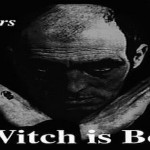Jason Mankey has encouraged me to explain yet again how and why I came up with those names. I suppose that may be useful. Over the years people have wanted to argue with me about which Sabbat Mabon should be associated with. Their arguments have been sensible, but not relevant, because that is not the question I was trying to answer. My question was, What myth might have been associated with the fall equinox? So why was I asking that? The story began when I was 13.
Rummaging through the boxes of books still stored out in the garage, I came across my tattered copy of Walt Kelly’s 1952 I Go Pogo, the second of the books that assembled his daily strips, and I recovered some faded memories. One was of how I became fascinated with holidays. The opening sequence in I Go Pogo, which I read and reread, often just before going to sleep, during the late 1950s and early 1960s, concerns the Bun Rabbit, who plays a drum and has decided to celebrate all the holidays at once and clear out the rest of the year. He then celebrates an eclectic series of holidays, almost none of which I had heard of at that time.

The sequence then climaxed with the Bun Rabbit proclaiming, “What’s untied? Whitsuntide! What’s untied on Whitsuntide? Rah!” That’s a riddle. I’ll come back to that
I began tracking down these strange terms, work that turned into a major research interest. It led me further and further into understanding the importance of holidays, and therefore of calendars, as being a major manifestation of religion in general. One can very often understand much more about a people’s religion from how they celebrate their holidays than from what they say.
I wrote a first draft of a book about calendars in about 1970, while working as a manuscript editor for Scientific American Books in San Francisco. Bill Kaufmann, then the President, liked it a lot, but assured me it just was not the kind of book they could publish. (Besides, I had only an M.A. at the time.)
Twenty years later, while working with Gordon Melton in Santa Barbara, I was paid to create a far more complete version of it, as Religious Holidays and Calendars: An Encyclopedic Handbook (Omnigraphics, 1993), incorporating data on most of the major, and many of the minor, religious traditions of the world. (By this time, since I had a genuine Ph.D., my opinion was taken more seriously, and I had even done a doctoral comprehensive exam on the Eleusinian Mysteries.) It is still, even with another editor’s name on it, the primary reference book on the subject.
Back in 1974, I was putting together a “Pagan-Craft” calendar—the first of its kind, as far as I know—listing the holidays, astrological aspects, and other stuff of interest to Pagans. We have Gaelic names for the four Celtic holidays. It offended my aesthetic sensibilities that there seemed to be no Pagan names for the summer solstice or the fall equinox equivalent to Yule or Beltane—so I decided to supply them.
The spring equinox was almost a nonissue. The Venerable Bede says that it was sacred to a Saxon Goddess, Ostara or Eostre, from whom we get the name “Easter,” which, almost everywhere else, is called something like “Pasch,” derived, of course, from Pesach.
Summer was also rather easy. The Saxon calendar described by Bede was lunisolar. It usually had 12 months, but in the third, fifth, and last month of an 8-year cycle, a 13th month was added to keep it (more or less) in sync with the solar years. The last and first months in the calendar were named Foreyule and Afteryule, respectively, and obviously framed the holiday of Yule. The sixth and seventh months were named Forelitha and Afterlitha; furthermore, when the thirteenth month was added, it went in between them, and the year was then called a Threelitha. Obviously, by analogy with Yule, the summer solstice must have been called Litha. (I later discovered that Tolkien had figured this out also.)
Another oddity of this Saxon calendar was that the fall equinox could occur in either of two months, depending on the intercalation cycle. Whichever month it fell in was called Halegmonat, that is, “Holy month,” and the other month was given a mundane name. So obviously the fall equinox was special to the Saxons also. But what was its name? I began wondering if there had been a myth associated with it.
While working for Scientific American Books, I had the immense privilege and pleasure of editing six books by Sir Fred Hoyle, astronomer and science-fiction author, and becoming his friend. In two of these books, he documented his proof that Stonehenge had been, as one archaeologist had guessed, a calculator that predicted, and still predicts, all eclipses of the Sun and the Moon. The first version of Stonehenge was a circle of 59 holes dug in the limestone, and some wooden posts to measure critical lines of sight. After Sir Colin Renfrew recalibrated radiocarbon dating, it turned out that first circle was constructed about 3000 BCE and so was as old as the first pyramids in Egypt. The big stones were not erected until about 1500 years later.
Where had this advanced astronomical knowledge come from? That’s a whole ‘nother line of thought.
Another peculiar feature of Stonehenge is a small circle of holes tangential to the main circle. Hoyle deduced that it could be used to calculate the date of the fall equinox, which therefore was an important day 5000 years ago. But important how? Are there any clues about that? Yes, not proofs, but definitely clues worth thinking about.
One very important clue is that the Athenian Greek calendar, which was also lunisolar, was calibrated so that the Eleusinian Mysteries, which were the actual religion of Greece, began at the full moon nearest the fall equinox. The oldest temple of Demeter at Eleusis dates to about 1500 BCE; its architecture is related to that of Crete, which civilization dates back to about 2500 BCE, and legend says that Demeter came from Crete. The Eleusinian myth and ritual, about the loss and recovery of Kore (which just meant “girt”), was obviously focused on offering an explanation of death, our one certainty, which we try so hard to be unsure about, and an afterlife, the embodiment of that uncertainty.
In the myth recorded in the Second Homeric Hymn to Demeter, Queen Metaneira of Eleusis interrupts Demeter, who has been searching for Kore, while she is about to make Metaneira’s son Demophon (which means “voice of the people”) immortal in the fire, and Demeter then founds the Mysteries. The brilliant Walter Burkert, in his Homo Necans, proposes that this scene contains the key to the “secret” of the Mysteries. In the climactic ritual in the Telesterion, the “pais ap’hestia,” the “child from the hearth,” who represented the Athenian people and who probably had been sedated with juice from Demeter’s sacred poppies, was swung through the bonfire, which was visible for miles. When the swing returned, in it was a black ram, sacred to Persephone, which was then sacrificed. The next-year’s initiates would stand on that sacred fleece when taking the oath of secrecy.
Here we obviously have the Greek correlate to the story of Abraham and Isaac, the story of a boy rescued from death. It is now common knowledge among classicists that the Greek myths and the Hebrew myths derive from common prototypes in the literature of about 1500 BCE, such as that discovered at Ugarit and Ras Shamra. Deborah Bender informed me that the story of Abraham and Isaac is read at Rosh Hashanah, which is at the new moon closest to the fall equinox.
There was another variant of the Kore type of myth, in which Theseus and Herakles rescue Helen of Troy from the underworld. So at this point there seems to be a complex of myths associating the fall equinox with the rescue of a young person from death, datable back to about 1500 BCE. There is solid archaeological evidence that there was regular trade and travel between Britain and the Mediterranean during the second millennium BCE. Might that association go back even farther, to perhaps 3000 BCE, because of that secondary circle at Stonehenge?
I began looking for a similar sort of myth in northern Europe. I could not find one in Germanic or Gaelic literature, but there was one in the Welsh, in the Mabinogion collection, the story of Mabon ap Modron (which translates as “Son of the Mother,” just as Kore simply meant “girl”), whom Gwydion rescues from the underworld, much as Theseus rescued Helen. It would have been aesthetically better to have found a Saxon name, but . . . so I picked “Mabon” as the name for the holiday in my calendar. It was not an arbitrary choice. I sent a copy of the calendar to Oberon (then still Tim), who liked these new names and began using them in Green Egg, whence they passed into the national Pagan vocabulary.
Oh, Walt Kelly’s riddle. It is a genuine riddle. Not giving you the answer wouldn’t be fair. It took me long enough to figure it out, and even when I tell you, you’ll still have to figure out for yourself why it’s the right answer. So, here (the envelope, please) is the answer:
Lady Godiva’s girdle. Have fun!
















